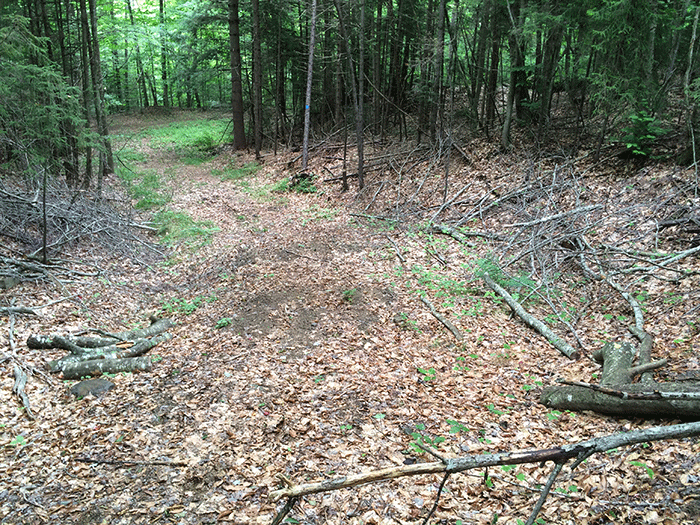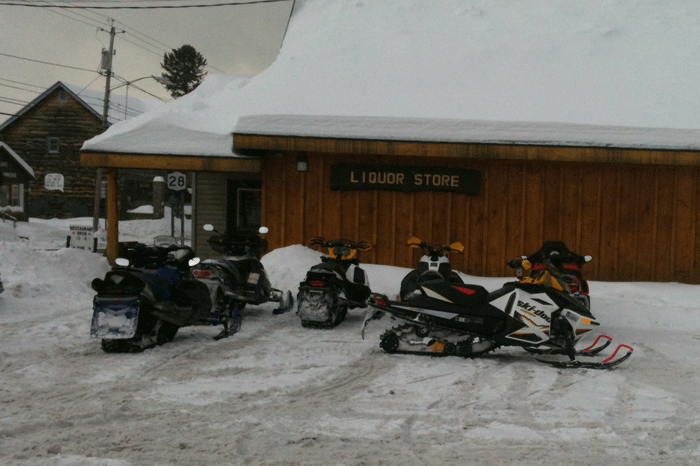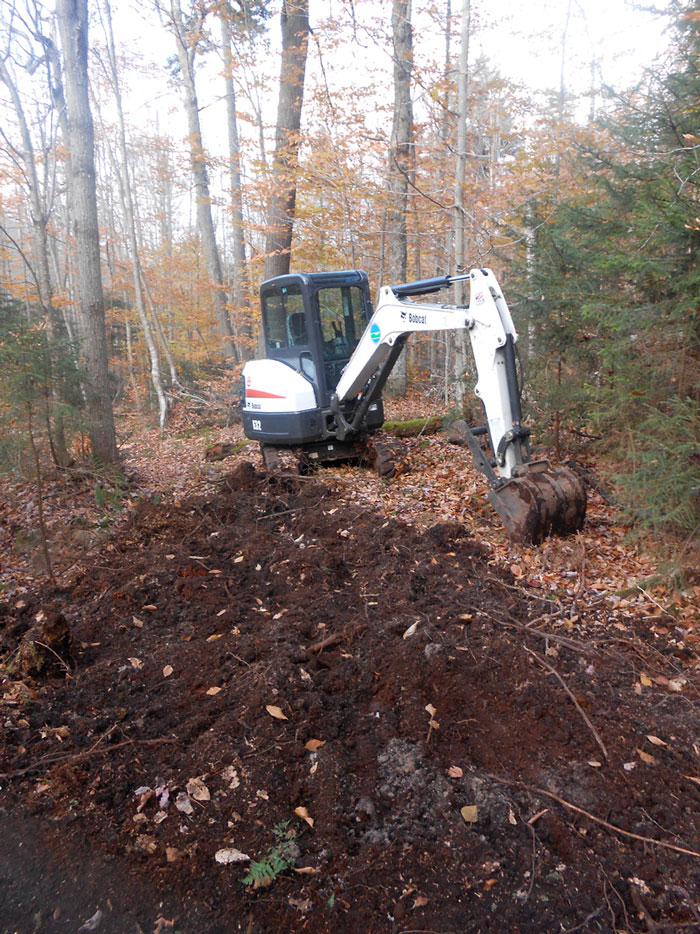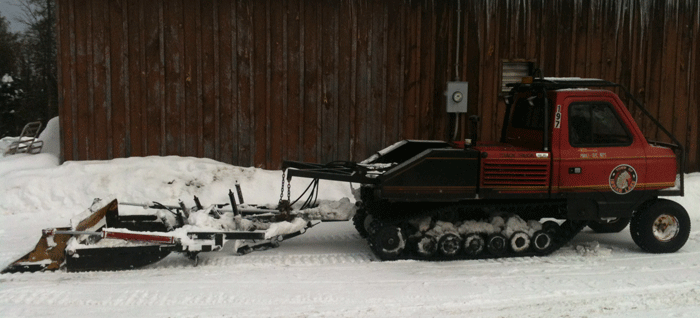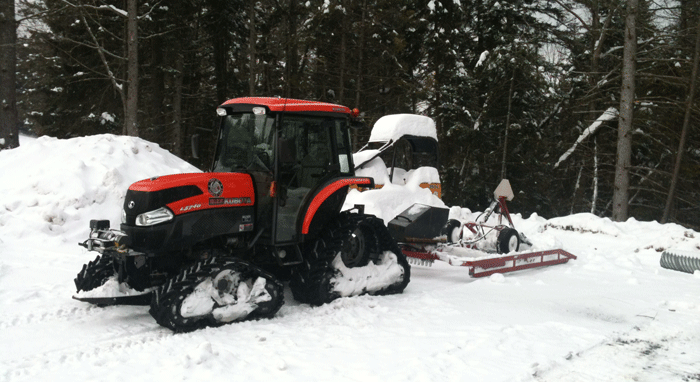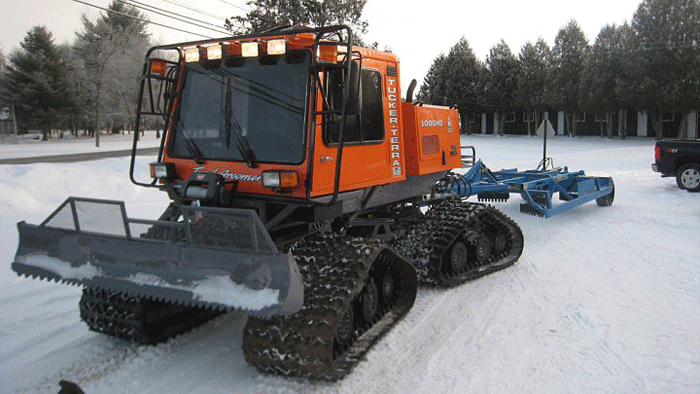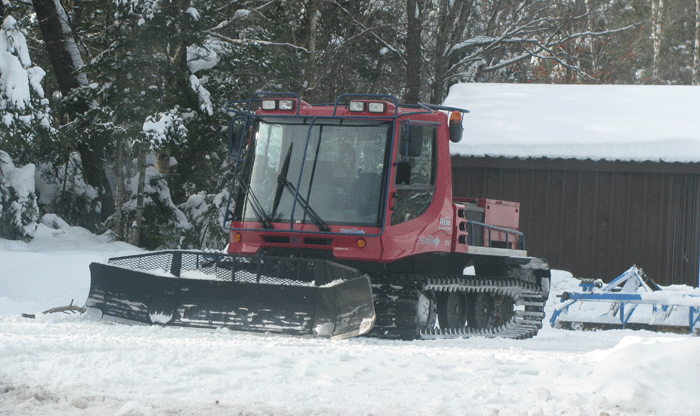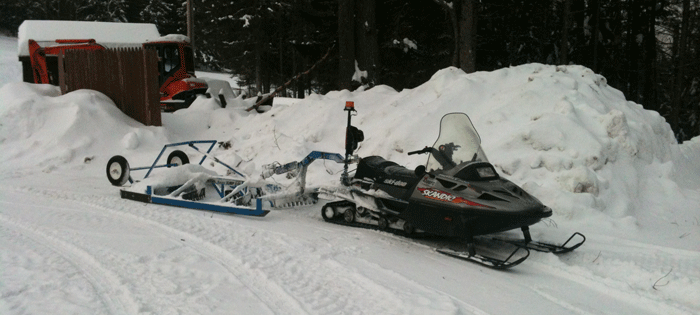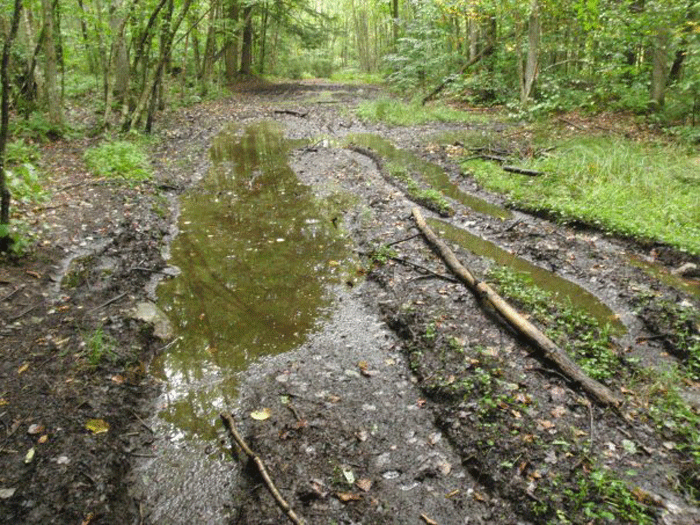Protect the Adirondacks has been monitoring the construction of the new community connector class II snowmobile trail from the Limekiln Lake-Cedar River Road to the Sagamore Road in Raquette Lake in the Moose River Plains Wild Forest Area, which is part of the state’s forever wild Forest Preserve. This “trail” is 9-12 feet wide (though it has a number of 20-foot wide spots) and extends roughly 12 miles through the Moose River Plains Wild Forest—five miles through an interior section and then seven miles parallel to Route 28.
See the full PROTECT letter to the DEC Commissioner and APA Chair.
PROTECT finds that this “trail” is for all practical purposes a new road built through the Forest Preserve. This “trail” appears to mark the beginning of a new age of robust Forest Preserve mismanagement for community connector class II snowmobile “trail” building by the Department of Environmental Conservation (DEC) and Adirondack Park Agency (APA). This snowmobile trail building is being managed under the auspices of the Snowmobile Plan for the Adirondack Park, various Wild Forest UMPs, and the Management Guidance: Snowmobile Trail Siting, Construction and Maintenance on Forest Preserve Lands in the Adirondack Park. PROTECT notes that these documents are all subordinate to the Adirondack Park State Land Master Plan (SLMP).
PROTECT’s field observations find that the “trail” was designed and is being built with specific road-like characteristics principally to accommodate the needs of large multi-ton tracked groomers that will groom the snow on this “trail.” The result is that this new community connector class II snowmobile “trail” and the activities for which it was built violate the SLMP and the State Constitution.
Please note that more than two dozen photographs of this “trail” have been posted to PROTECT’s website that illustrate many of the points in this letter.
Community Connector Class II Snowmobile Trail Construction Violates the Adirondack Park State Land Master Plan
The SLMP defines a snowmobile trail as “a marked trail of essentially the same character as a foot trail” and mandates that it be “compatible with the wild forest character of an area.” A snowmobile trail “should be designed and located in a manner than will not adversely affect adjoining private landowners or the wild forest atmosphere….” This road-like “trail” in the Moose River Plains Wild Forest, which is the new state-of-the-art template for future community connector class II snowmobile trails, does not have the character of a foot trail and violates both the wild forest character and the wild forest atmosphere of the area. PROTECT has consistently stated that community connector class II snowmobile trails do not conform to these three standards. This new “trail” is further proof.
There is no way this new community connector class II snowmobile “trail” bears any rational resemblance to something having the “character of a foot trail.” This new snowmobile “trail” surface has been graded, leveled, and flattened by a nine-thousand-pound excavator (see below). Extensive bench cuts were dug into side slopes that parallel the “trail” in many sections for a hundred yards, protruding rocks removed, extensive tree cutting done, all understory vegetation removed, and oversized bridges built to support multi-ton groomers. Ledge rock was fractured and split apart, trail surface scarred by 6-wheel ATVs that made deep wheel ruts, and extensive amounts of crushed gravel used. Bridges have been outfitted with plastic reflectors for night-time driving.
A “foot trail” is where people walk single file. They step over roots and rocks. The trail surface is uneven and follows the terrain. There are scarcely any stumps of cut trees. Vegetation on the side often encroaches, and the trail is canopy covered. Steppingstones and split logs are commonly used to pass over streams and wet areas. There are no reflectors.
PROTECT is also on record stating that the community connector class II snowmobile trail system as authorized in the Snowmobile Plan and Guidance cannot be built on a designated “trail” in Wild Forest areas without violating the SLMP. SLMP Wild Forest Basic Guideline 4 states “Public use of motor vehicles will not be encouraged and there will not be any material increase in the mileage of roads and snowmobile trails open to motorized use by the public in wild forest areas that conformed to the master plan at the time of its original adoption in 1972.”
PROTECT is not going to argue here that this road-like snowmobile trail in the Moose River Plains Wild Forest violates Basic Guideline 4 by constituting a “material increase” in the mileage of snowmobile trails. We recognize that the Moose River Plains UMP closed a number of snowmobile trails and that use is being rerouted and concentrated on this new trail. This new road-like snowmobile trail, however, does violate Basic Guidelines 4 by “encouraging” more snowmobile use.
PROTECT has identified that there are many other areas of the SLMP that were expressly violated by the design and construction of community connector class II snowmobile trails, their intended use, and by grooming with large tracked (motor vehicle) groomers. These include:
• Basic Guideline 2 (Motor Vehicles, Motorized Equipment and Aircraft 6) states that public access accommodations should be “consistent with the wild forest character.” PROTECT does not believe that the new road-like community connector class II snowmobile road built in Moose River Plains Wild Forest (MRPWF) is consistent with the wild forest character. The route’s width, bridges, reflectors, bench cuts, ledge cuts, use of gravel and straw, extensive surface alteration, over 2,000 stumps, and removal or trees and rocks are all inconsistent with the “wild forest character” of this area.
• Basic Guideline 2 (Motor Vehicles, Motorized Equipment and Aircraft #8) states “All conforming structures and improvements will be designed and located so as to blend with the surrounding environment and require only minimal maintenance.” PROTECT does not believe that the new road-like community connector class II snowmobile trail in the MRPWF meets the minimal maintenance test expressed here. DEC and the APA claim that the grooming of this trail is maintenance. PROTECT does not believe that numerous trips per week by a multi-ton tracked groomer on a major snowmobile route meets the “minimal maintenance” test.
• Basic Guideline 2 (Motor Vehicles, Motorized Equipment and Aircraft 9) states “All management and administrative actions and interior facilities in wild forest areas will be designed to emphasize the self-sufficiency of the user to assume a high degree of responsibility for environmentally sound use of such areas for his or her own health, safety and welfare.” Leaving aside concerns of snowmobile “environmentally sound use” with their mileage rates less than most SUVs, PROTECT questions the “self-sufficiency” of the users of the new road-like community connector class II snowmobile trail built in MRPWF where the principal recreational use of snowmobiling can only be accomplished if the trail has been regularly groomed by a multi-ton tracked groomer.
• Basic Guideline 2 (Structures and Improvements 1C) states that snowmobile trails are allowed in Wild Forest areas and “their maintenance, rehabilitation and construction” is allowable by “snowmobiles on snowmobile trails.”
There are two major points here where the DEC and APA brazenly violate the SLMP.
1. A snowmobile is the only motor vehicle lawfully allowed on a designated trail by the SLMP.
PROTECT does not believe that a multi-ton tracked groomer is a snowmobile. Under the SLMP motor vehicles, such as groomers, can only operate on designated roads. In the SLMP, snowmobiles are the only motor vehicles allowed on a snowmobile trail that is also a designated foot trail. PROTECT notes that the new road-like community connector class II snowmobile trail built in Moose River Plains Wild Forest was designed and built specifically to accommodate large tracked groomers. PROTECT believes that groomer use on designated trails is an explicit violation of the SLMP.
PROTECT notes that the APA and DEC try to get around the SLMP’s prohibition against use of motor vehicles on designated trails in Wild Forest areas in the approved Guidance, which states in “Grooming and Associated Winter Maintenance Trips” that class II snowmobile trails authorize “grooming equipment with a tractor and drag….” PROTECT believes that a “tractor” is a motor vehicle. Despite the attempts to use the Guidance to somehow legalize the SLMP’s prohibition of use of motor vehicles other than snowmobiles on “trails” in Wild Forest areas, the APA and DEC’s authorization of this use clearly violates the SLMP.
The SLMP is clear that the only motor vehicle that can operate on a snowmobile trail is a snowmobile. PROTECT does not dispute that these motor vehicles can lawfully be used on designated roads (many snowmobile “trails” utilize the designated roads system in Wild Forest areas of the Forest Preserve). Snowmobile trails on designated “trails” should only be groomed by a snowmobile that pulls a drag.
The use of a large multi-ton groomer on a designated trail changes everything. This is the key fact obfuscated by APA and DEC in the Guidance.
Below are five pictures of various motor vehicles used for grooming trails and roads on the Forest Preserve designated as snowmobile trails. The top two show types of tracked groomers that pull drags used by the Town of Indian Lake and other communities. They are 5-6 feet wide. These groomers are quite small compared with many used in other locations, such as the third and fourth pictures of large groomers used around Cranberry Lake and Inlet. The fifth picture is of a snowmobile outfitted with a drag used by the Town of Indian Lake. The SLMP states that the only motor vehicle allowed on a designated “trail” in the Forest Preserve is a snowmobile such as the one shown in the fifth picture. All other motor vehicles, such as the four large tracked groomers shown below, should only be used on designated roads.
2. The snowpack on a community connector class II snowmobile trail is groomed by large tracked groomers. This is not trail maintenance sanctioned by the SLMP.
The SLMP states that the “… the use of motor vehicles, motorized equipment and aircraft will be allowed [on Wild Forest] as follows…by administrative personnel where necessary to reach, maintain or construct permitted structures and improvements.” Note that the SLMP does not say “reach, maintain, groom or construct…” which it would have to if grooming was allowed by a motor vehicle on a designated “trail” rather than a snowmobile with drag.
Snowmobile trails are listed as an “improvement” in the SLMP. The SLMP states that such improvements can be maintained. Though the SLMP does not define “maintenance” it does provide guideposts for how to interpret and apply maintenance standards for improvements in Wild Forest areas.
First, it’s important to note the function that large multi-ton tracked groomers perform. They do not maintain a trail. They simply flatten the snow. Flattening of snow is not maintenance of a trail. Maintenance is an action that changes the land, to clear a trail, repair bridges, build water bars, remove blowdown, among many other activities. The DEC used plenty of motor vehicles to “reach, maintain or construct” the new community connector class II snowmobile trail in the Moose River Plains. They used ATVs and they used a 9,000-pound excavator. These motor vehicles altered the trail surface or transported work crews and/or materials long distances. Groomers, however, simply flatten the snow. They do not change the land and as such cannot be considered to perform maintenance under any rational SLMP interpretation.
The SLMP consistently separates maintenance (of a trail) from grooming (of the snow covering a trail). For context, note that the SLMP states that an “improved” cross-country ski trail can be “groomed” but should only be found in “intensive use conditions,” such as the Mt Van Hoevenberg Winter Recreation Area, and is not something that’s allowable in a Wild Forest area. (See page 15 for “Improved Cross Country Ski Trail.”)
The SLMP simply does not contemplate grooming of snowmobile trails on a designated “trail” with anything other than a snowmobile, yet this is explicitly what the APA and DEC approved in the Guidance, which sanctions large “tractors” on trails to perform “maintenance.” The result is that the new “trail” through the Moose River Plains has been designed for an unlawful activity — grooming by a multi-ton motor vehicle on a trail.
The approved Guidance may state that somehow use of motor vehicles other than snowmobiles is lawful on designated “trails,” but this affirmation cannot erase the requirements of the SLMP. In this respect, the Guidance is a deceptive document, wholly inconsistent with the SLMP.
The “Snowmobile Route, Design, Construction and Maintenance Standards” section in the Guidance references the 2010 APA-DEC MOU “Concerning Implementation of the State Land Master Plan” for a definition of “ordinary maintenance activities.” A review of this MOU finds no mention of the grooming of snowmobile trails in the definition for ordinary maintenance activities.
Community Connector Class II Snowmobile Trail Construction Violates Guidance
Just as the approved Guidance violates the SLMP, the actual work undertaken to build this new community connector class II snowmobile trail in the Moose River Plains violated the requirements of the Guidance. PROTECT notes six areas where work in the field violated the Guidance. The Guidance enumerates permissible activities within the “Snowmobile Route Design, Construction and Maintenance Standards” section.
• The Guidance states “Class II Trails may be maintained to a 9-foot maximum cleared trail width except on sharp curves (inside turning radius of 25-35 feet) and steep running slopes (over 15%) where they may be maintained to a 12-foot maximum cleared trail width.” There are many locations on the new road-like community connector class II snowmobile trail built in Moose River Plains Wild Forest that are greater than 12 feet.
• The Guidance states “Class II Trails. Trail surfaces should generally follow the existing contours of the natural forest floor and not be graded flat. Limited leveling and grading may be undertaken using appropriate low-impact landscaping equipment as specified in the work plan.” The new road-like community connector class II snowmobile trail built in Moose River Plains Wild Forest has long stretches where the trail was graded flat. Moreover, PROTECT does not consider the 9,000-pound excavator used throughout this project as “low impact landscaping equipment.”
• The new road-like community class II snowmobile trail built in Moose River Plains Wild Forest included instances of bedrock removal. This is not authorized by the Guidance and has never been allowed before in the Forest Preserve.
• The Guidance contains a section on “Side Slope Management” that states “On Class II Trails, elimination or reduction of side slopes will be accomplished primarily by means of full bench cuts for which appropriate landscaping equipment may be used. The need for bench cuts will be minimized through proper trail layout. The tapering of side slopes will be allowed outside the cleared trail width. The areas dressed and tapered will be re-vegetated to restore stability and natural site conditions after the full bench cut is created.” The new road-like community connector class II snowmobile trail built in Moose River Plains Wild Forest contains extensive bench cuts that have not been re-vegetated.
• The new road-like community connector class II snowmobile trail built in Moose River Plains Wild Forest includes extensive use of crushed stone and straw, both non-native materials. The Guidance does not authorize this use.
• A review of DEC work plans finds that activities undertaken to build the new road-like community connector class II snowmobile trail built in Moose River Plains Wild Forest were often undertaken before official approval from the APA.
Community Connector Class II Snowmobile Trail Construction Raises Constitutional Questions
Beyond the SLMP violations, this “trail” raises serious constitutional questions. Article 14 of the State Constitution declares that the Forest Preserve “shall be forever kept as wild forest lands.” This trail hardly meets that test as it is a 12-acre clearcut and the land has been massively altered. The Constitution says that trees should not be “destroyed” yet by DEC’s own count, over 2,000 trees were destroyed to build this “trail” (independent assessments are higher).
PROTECT and other groups are actively researching these questions concerning constitutional violations.
Why is Community Connector Class II Snowmobile Trail Building Accelerating as Winter Weather Declines Due to Climate Change?
PROTECT believes that the APA and DEC should view the current rush of community-connector class II snowmobile trail construction in light of global climate change. In the year 2013, we now live in an Adirondack Park where it’s as likely to rain in winter months as it is to snow. We live in a part of the world that receives 30 percent more rain than it did thirty years ago. Winter months show greater warming trends than summer months. The future will bring inconsistent snowmobile seasons at best, which is already borne out in the marketplace by declining snowmobile sales.
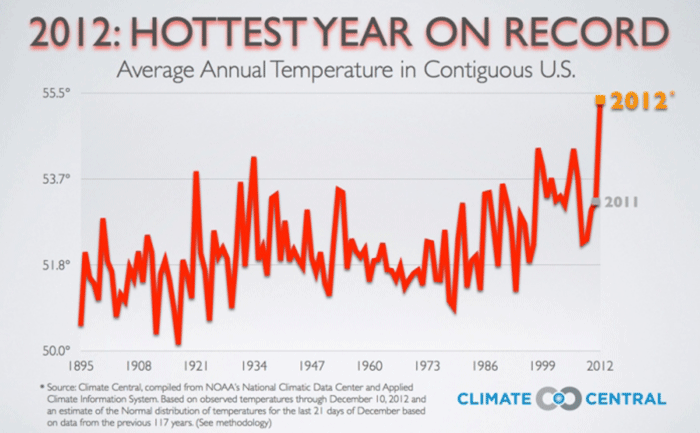
10 of the warmest years on record in the U.S. have been in the last 15 years, but nothing beats 2012.
PROTECT is puzzled how the two lead agencies for environmental issues in New York State can make major policy decisions as well as administrative financial decisions without taking into account the effects of long-term trends of global climate change on the Adirondack Park.
PROTECT Predicts APA and DEC will Transform Snowmobile Trail Network to ATV Trail Network as Reliable Snowfall Wanes
PROTECT predicts that the APA and DEC someday will issue a new “Guidance” to convert intermittently snowless community connector class II snowmobile trails into community connector all-terrain vehicle trails. As snowmobiling wanes we have no confidence that these agencies will withstand pressure to unleash vast ATV networks across the Forest Preserve. The damage from ATV trails networks to the Forest Preserve will be vast and unrelenting as we already have seen in areas such as the Shaker Mountain Wild Forest where DEC has been unable to control illegal ATV abuse. We expect to hear the same arguments, justifications, and obfuscations that the DEC and APA used to build a community connector class II snowmobile trail system being used to create a new ATV “trail” system on the Forest Preserve.
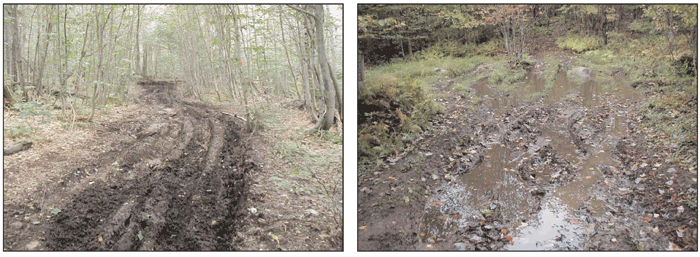
The three pictures above illustrate widespread ATV damage on the Forest Preserve. DEC has been incapable of protecting the Forest Preserve from the ravages of ATV abuse.
Conclusion
PROTECT understands that DEC and the APA are very proud of this new community connector class II snowmobile trail in the Moose River Plains and believe it is a new template for design, maintenance and grooming for this trail network. Many more just like it will follow and others are already under construction.
Both agencies appear completely unfazed by clear violations of the SLMP by the Guidance and actual trail construction and use. This is unfortunate.
The Forest Preserve is the finest state public land system in the United States. It deserves better management by its public stewardship agencies.

